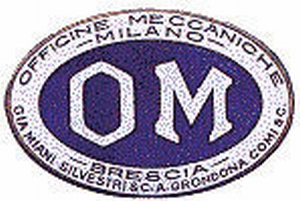
Officine Meccaniche or OM was an Italian car and truck manufacturing company. It was founded in 1899 in Milan as Società Anonima Officine Meccaniche to manufacture railway rolling stock and car production began in 1918. It disappeared as such in 1975, subsumed into Iveco, but still exists as a forklift builder.
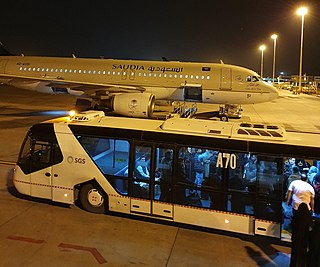
Neoplan Bus GmbH is a German automotive company that manufactures buses, trolleybuses and coaches. Since 2001, it has been a subsidiary of MAN Truck & Bus SE.
Innocenti was an Italian machinery works, originally established by Ferdinando Innocenti in 1920. Over the years, they produced Lambretta scooters as well as a range of automobiles, mainly of British Leyland origins. The brand was retired in 1996, six years after being acquired by Fiat.

AMAG Group Ltd is a Swiss corporate group primarily active in the automotive trade. Since September 2019, the administration of the entire AMAG group has been based in Cham in the canton of Zug[2], after relocating from Utoquai 49 in Zurich, where the group had been based since its foundation. The group employs around 6600 people and generated revenue of CHF 4.7 billion in 2019. The group is owned by the private holding company BigPoint Holding AG, in turn owned by Martin Haefner.

Daimler-Motoren-Gesellschaft was a German engineering company and later automobile manufacturer, in operation from 1890 until 1926. Founded by Gottlieb Daimler (1834–1900) and Wilhelm Maybach (1846–1929), it was based first in Cannstatt. Daimler died in 1900, and their business moved in 1903 to Stuttgart-Untertürkheim after the original factory was destroyed by fire, and again to Berlin in 1922. Other factories were located in Marienfelde and Sindelfingen.

Gräf & Stift was an Austrian manufacturer of automobiles, trucks, buses and trolleybuses, from 1902 until 2001, latterly as a subsidiary of MAN. It was founded in 1902 by the brothers Franz, Heinrich and Karl Gräf, and the investor, Wilhelm Stift. Before the Second World War, the company was a well-known manufacturer of luxury automobiles, including the Double Phaeton that carried Archduke Franz Ferdinand and his wife, Sophie, when they were assassinated in Sarajevo in June 1914. By the 1930s Gräf & Stift had begun making trucks and buses, and it ceased car manufacturing in 1938. The company merged with Österreichische Automobil Fabriks-AG (ÖAF) in 1971, becoming ÖAF-Gräf & Stift AG, and later the same year was taken over by MAN AG. It continued in business as a subsidiary of MAN, and the Gräf & Stift name remained in use as a MAN brand for the Austrian market and for trolleybuses until 2001, when ÖAF-Gräf & Stift AG was renamed MAN Sonderfahrzeuge AG. It was located in Vienna, and the production facilities continue in use there, but no longer using the Gräf & Stift name.

The Tribelhorn was a Swiss electric car manufactured from 1899 until 1919 in Zurich. Production began in earnest in 1902; three- and four-wheelers were offered. The company also produced trolleytrucks that were used in Gümmenen and Mühleberg Switzerland between 1918 and 1922 during the construction of a dam. It produced only light utility vans after 1919 when it was taken over by EFAG.
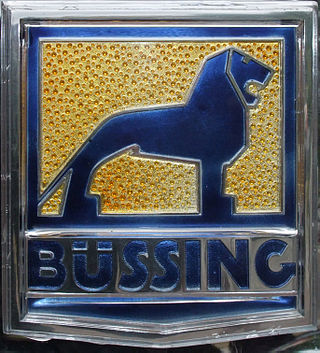
Büssing AG was a German bus and truck manufacturer, established in 1903 by Heinrich Büssing (1843–1929) in Braunschweig. It quickly evolved to one of the largest European producers, whose utility vehicles with the Brunswick Lion emblem were widely distributed, especially from the 1930s onwards. The company was taken over by MAN AG in 1971.
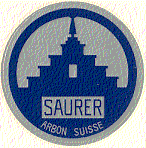
Adolph Saurer AG was a Swiss manufacturer of embroidery and textile machines, trucks and buses under the Saurer and Berna brand names. Based in Arbon, Switzerland, the firm was active between 1903 and 1982. Their vehicles were widely used across mainland Europe, particularly in the interwar period.

Franz Brozincevic & Cie (FBW) was a Swiss maker of trucks, motorbuses and trolleybuses, founded by Croatian-born engineer and constructor Franjo (Franz) Brozinčević (1874-1933), active between 1922 and 1985 and based in Wetzikon, canton of Zürich.
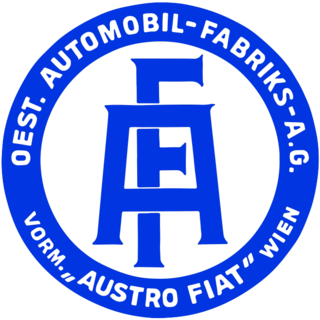
ÖAF is an initialism for Österreichische Automobil-Fabrik, previously known as Österreichische Austro-Fiat, an Austrian (Austro-Hungarian) car and truck manufacturer that now is completely incorporated into MAN.

Nahkampfkanone 2 is a prototype tank destroyer of Swiss design.
Serbia's automotive industry is one of the most important industrial sectors and makes about 15% of industrial output of the country and 18% of all exports.
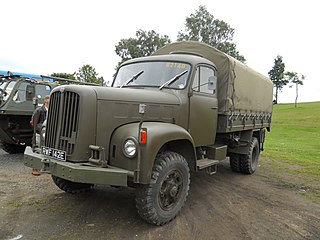
The Saurer 2DM is a truck model, which established by the Adolph Saurer AG at Arbon from in 1959. The payload of 4.9 tonnes, it is a right hand drive. The Swiss Army used the 2DM since 1964, in several special versions, such as dump trucks, snow plow or tanker for aircraft or tanks. Almost identical was the model Berna 2VM from Berna Olten. Starting in 1964, approx 3200 units were built in all different varieties. The 2DM was also sold for civilian purposes.

The Saurer 2 CM is a 4x4 truck model established by the Adolph Saurer AG in 1949 with a payload of 2.5 tons. There were 222 build most of them with a loading bridge, while some were made with a fixed structure as a van. The vehicles are right-hand driven. A winch was optional. The Saurer CM2 was also built by Berna and FBW under their own names. The Saurer CM 2 formed the basis for other vehicles with more powerful engine and a larger payload capacity like Saurer 4CM 5t, Saurer 4CM driving school cars, Saurer Woodcarrier 4CM, 5CM 6t Saurer trucks and a mobile command center of the flab. One is on display at the Schweizerisches Militärmuseum Full.

Protos of Nonnendamm was a German car manufacturing company founded in 1898 in Berlin by engineers Alfred Sternberg and Oscar Heymann.

The Berna 2VM is a 4x4 truck model that Berna, at Olten, from 1964 to 1976 in total 1600 pieces produced. The company Berna was in 1929 purchased by Adolph Saurer AG. T The Swiss Army used the Berna 2VM in several special versions, such as dump trucks, snow plow or tanker for aircraft or tanks. Almost identical was the model Saurer 2DM from the Adolph Saurer AG in Arbon. The Berna 2VM was also sold for civilian purposes. One is on display at the Schweizerische Militärmuseum Full.

The Berna L275/10 is a truck model manufactured by the Swiss company Berna from 1937 onwards. The Berna L275 / 10, military designation "Lastw gl 1.5t 4x2", has a total weight of 2200 kg, a structure with cabin and bridge as well as an on-board voltage of 6 V. The 6-cylinder petrol engine with 3600 cm³ produces a power of 66 kW (90 hp).
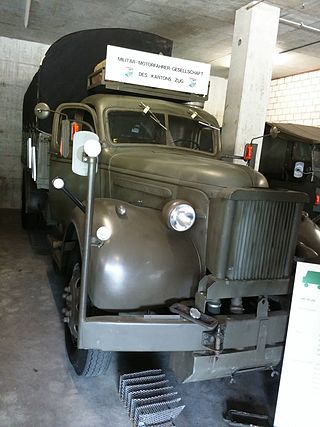
The GMC AC 454 is a truck model that the GMC manufactured from 1940 on.
The Militärhistorische Stiftung des Kantons Zug MHSZ is a foundation consisting of a group of Military Museums in the canton of Zug with the purpose of safeguarding and cultivating the military heritage of the Swiss Confederation in the canton of Zug.
































